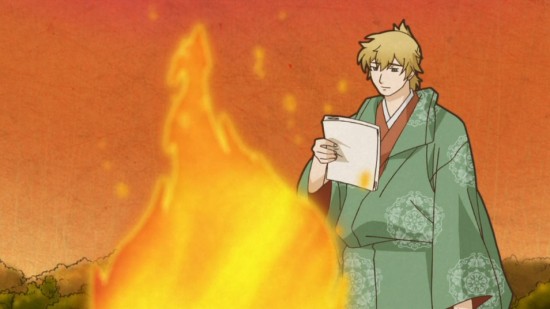Let me be clear about this. I enjoyed Utakoi. Still, I think mine is very much a minority taste.
In my original post I went into some detail about what I like about this show. Now that it’s over, just to be perverse I’m going to list some reasons why most people probably won’t like it.

First, you really have to be at least a little bit interested in traditional Japanese poetry. If the subject makes you roll your eyes you had best stay far away from this.
On the other hand it probably is not a good thing if you are an expert on the subject. Utakoi is gleefully middlebrow, never letting the historical record stand in the way of a good story. The medieval poets banter with each other using modern slang. They make witty asides to the 21st century audience and engage in anachronistic activities during comic filler segments. To someone who is really serious about the subject this might get pretty annoying.
Also this is not the place to look for happy endings. For Heian Period aristocrats marriage was a matter of family obligation. It generally was about as romantic as getting your oil changed. Romance, if it occurred at all, consisted of a secret affair with an unsuitable partner. It would inevitably lead to a tearful farewell, but it might then be commemorated by a beautiful poignant poem which would be admired centuries later, long after the original participants were forgotten.
As I said before, this show has some beautiful images, as befits a story set in the Imperial Court of the Heian Period. However the artwork is only praiseworthy when viewed as still images. As animation it is pretty bad.
Television animation is always subject to tight budget constraints. Part of the art form is the ability to keep costs under control while still making it look good (or, failing that, at least keep if from looking bad.) In this area the production often falls down.
The most painful failures involve the elaborately patterned silk kimonos favored by medieval aristocrats. It is admirable that the producers wanted to depict these garments, but there are good reasons why most historical anime series just show them wearing solid colors. It is very expensive to hand-animate patterned fabric.
What Utakoi generally does is make the kimono transparent and put the pattern in a separate layer. They usually get away with this as long as they are showing a still image, but once the characters move the illusion is destroyed and it looks awful. If the animation looks jarringly wrong then you aren’t doing it right.
(What would be the right approach? Probably to use a computer to render the fabric, then flatten the image so that it fits seamlessly onto the hand-drawn figure. Studio Ghibli could probably do it. They probably have done it, but so skillfully that I didn’t notice. In any case it’s clearly beyond the capabilities of this production.)
One thing that’s been puzzling me: what’s the proper translation of Utakoi? My first response was that it should be “Love Poems” but that violates the rule that the modifier always comes before the thing modified. A better translation might be “Love of Poetry,” which would probably fit the theme of the series better.

